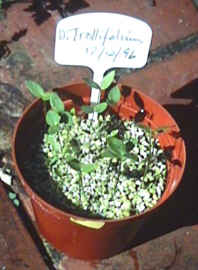 After three years experience
with D. trolliifolium, my conclusion is that difficulties arise
because the seed needs a prolonged period (12 weeks or more) of
exposure to cold, moist conditions for germination.
After three years experience
with D. trolliifolium, my conclusion is that difficulties arise
because the seed needs a prolonged period (12 weeks or more) of
exposure to cold, moist conditions for germination.
| Return to American Species Contents List |
| North American Delphinium Species 2a |
The following account of our experience in growing this species from the Pacific North West region of the U.S.A. is an illustrated and revised version of an article that appeared in the Spring 2000 issue of the Bulletin of The Hardy Plant Society of Oregon, Vol. 16.
by David Bassett
The story begins in 1996 when Delphinium Society member Stephen Murphy of Vancouver WA obtained a permit to collect seeds of delphinium species from the Columbia Gorge region. These were sent to me as Seed Manager of the Delphinium Society for distribution to our members.Initial reports received from recipients, whether in Canada, New Zealand or the UK, were all of frustration associated with germination problems or failure of the seedlings to make good plants in the first year.
 After three years experience
with D. trolliifolium, my conclusion is that difficulties arise
because the seed needs a prolonged period (12 weeks or more) of
exposure to cold, moist conditions for germination.
After three years experience
with D. trolliifolium, my conclusion is that difficulties arise
because the seed needs a prolonged period (12 weeks or more) of
exposure to cold, moist conditions for germination.
Seedlings of this tuberous-rooted perennial also seldom grow a sufficiently large root tuber before the period of dormancy during summer and autumn for the plants to flower even in their second year.
I sowed the seeds of D. trolliifolium at Christmas and simply left the pot outdoors exposed to the weather, which included a few periods of frost and snow. Germination started in late February and quite a few seedlings were present by the end of March. [The seedlings have a pair of seed leaves (cotyledons) at the top of a single stalk, as in the more familiar Californian species D. nudicaule. Examination of seedlings shows that a tiny root tuber is formed at a very early stage and that the true leaves grow from this tuber.] Just two or three produced a single small true leaf but by June everything had withered away. I resisted the temptation to discard the pot and kept it fairly dry for the rest of the year.
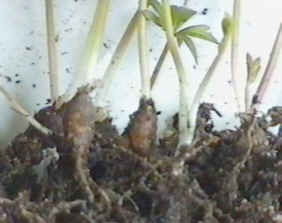 A magical resurrection occurred in the following
February when several divided leaves, obviously of delphiniums,
began to break through the surface after the compost had been
moistened by winter rain. At that stage I re-potted the
seedlings.
A magical resurrection occurred in the following
February when several divided leaves, obviously of delphiniums,
began to break through the surface after the compost had been
moistened by winter rain. At that stage I re-potted the
seedlings.
There were about 25 little carrot-like root tubers. The largest (about 15mm long x 5mm diam.) probably were the seedlings that had developed a true leaf in the previous year.
The two seedlings with the largest tubers went on to produce a flower stem but the remainder developed no more than three basal leaves. By July the whole batch had again died off and become dormant.
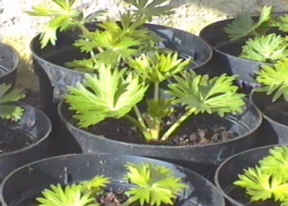 This time the dormancy period included a house move and
the pots were rather neglected until I noticed growth restarting
in one pot in early December. The whole batch was then re-potted
into 2 litre pots using a wide range of different compost mixes
from peat-based commercial compost to mixes including mole-hill
soil and even rotted horse manure. I added ground-up local
limestone and some compound fertiliser to most of the mixes. In
fact the compost seemed to make very little difference as the
plants in all 17 pots grew and flowered well. [Mary Hoffman, Editor of the HPSO
Bulletin, expressed some surprise at my use of limestone and
noted that the soils of the Columbia Gorge are generally very
acid]
This time the dormancy period included a house move and
the pots were rather neglected until I noticed growth restarting
in one pot in early December. The whole batch was then re-potted
into 2 litre pots using a wide range of different compost mixes
from peat-based commercial compost to mixes including mole-hill
soil and even rotted horse manure. I added ground-up local
limestone and some compound fertiliser to most of the mixes. In
fact the compost seemed to make very little difference as the
plants in all 17 pots grew and flowered well. [Mary Hoffman, Editor of the HPSO
Bulletin, expressed some surprise at my use of limestone and
noted that the soils of the Columbia Gorge are generally very
acid]
The plants were kept in a cold frame until they grew too tall and, in a mild, almost frost-free winter, grew very strongly with large basal leaves. Flower stems began to grow up in February and the first flower opened by 31st March. The Columbia Gorge has no monopoly on strong winds and our new garden has no hedges to provide protection against the howling gales that sweep across the top of the Cotswold hills. Shade netting was used to provide a wind-break and it was necessary to tie the delphinium stems to a cane to avoid breakage during the phase of rapid growth when they were soft and fragile. At flowering time the stems were hard and tough.
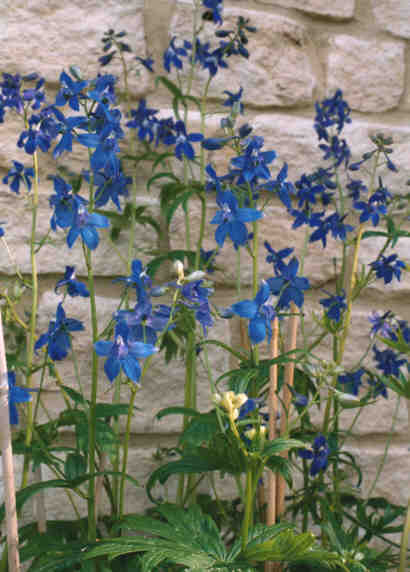 In flower, the plants were reminiscent of poorish
quality annual larkspurs, with a short terminal raceme of flowers
on a tall stem and secondary flowers on side shoots. Most plants
had a basal group of at least four leaves with a single flowering
stem from 75 to 105 cm tall having from 2 to 8 leaf joints below
the terminal raceme. The number of flowers in the bloom ranged
from 7 to 21 and was clearly linked to the number of leaves on
the stem. There was also a surprisingly large range of variation
in the form of the bloom and the characteristics of the flowers.
Just as in garden delphiniums, some blooms were narrow columns
while others were nicely tapered pyramids. The flowers could be
generally described as being mid-blues with a small white eye
associated with the spur petals. The colour actually varied from
fairly pale violet to intense deep violet shades, with only one
plant having beautiful large florets of a pure gentian blue. I
was surprised by the range of the variations in this group of
plants, although Stephen Murphy had noted that the plants were
quite varied in colour in the area where he collected seed.
In flower, the plants were reminiscent of poorish
quality annual larkspurs, with a short terminal raceme of flowers
on a tall stem and secondary flowers on side shoots. Most plants
had a basal group of at least four leaves with a single flowering
stem from 75 to 105 cm tall having from 2 to 8 leaf joints below
the terminal raceme. The number of flowers in the bloom ranged
from 7 to 21 and was clearly linked to the number of leaves on
the stem. There was also a surprisingly large range of variation
in the form of the bloom and the characteristics of the flowers.
Just as in garden delphiniums, some blooms were narrow columns
while others were nicely tapered pyramids. The flowers could be
generally described as being mid-blues with a small white eye
associated with the spur petals. The colour actually varied from
fairly pale violet to intense deep violet shades, with only one
plant having beautiful large florets of a pure gentian blue. I
was surprised by the range of the variations in this group of
plants, although Stephen Murphy had noted that the plants were
quite varied in colour in the area where he collected seed.
Overall the group of plants provided a nice splash of colour throughout April and contrast in form to the other spring flowers in our garden. The real test of their garden value is now to assess how well they survive if planted in the soil. Losses were small for dormant tubers in pots and they might survive among the celandines and bulbs in the areas under tree shade that are dry in summer. The ever present slugs are a menace, however, and I suspect they might be the winners!
| Questions Do seedlings in the wild develop to flowering just as slowly as we have found? What proportion of seedlings in the wild actually survive to flowering? On average, how old are the flowering plants in a wild population? |
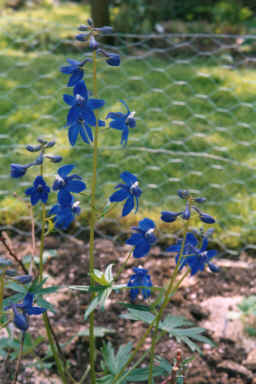 Experience with open-ground plants
Experience with open-ground plants
The plants grown in pots in 1998 and 1999 survived the winters with few losses and in spring 2000 most were planted in the garden. One site was in a very stony (limestone) scree bed. The other was in shade with sticky clay soil. All plants flowered well. An interesting feature was that the plant with the best flowers, which was put into a sunny site in the scree bed, produced new stems from the base and flowering continued until July when all plants became dormant.
With exceedingly wet conditions from late September until early January 2001, it was expected that the survival rate for these plants would be poor. In fact new growth began to appear in December and by late January most of the plants had a rosette of new leaves through the ground.
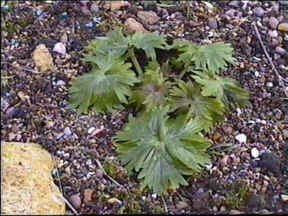 These were subjected to quite hard
overnight frost during January. The picture here shows the most
advanced plant and there seems to be some sign of frost damage to
the leaves. After a few days of milder weather, all the plants
continued to grow. Further hard frost occurred but the plants
were unaffected and it is clear that this species is well able to
withstand an average winter in southern England.
These were subjected to quite hard
overnight frost during January. The picture here shows the most
advanced plant and there seems to be some sign of frost damage to
the leaves. After a few days of milder weather, all the plants
continued to grow. Further hard frost occurred but the plants
were unaffected and it is clear that this species is well able to
withstand an average winter in southern England.
The plants made rapid progress towards flowering in March but poor weather retarded growth and flowering was delayed until late April. Most plants were in flower during early May, even those in a heavily shaded site. Each mature plant produced several stems up to 1m (3 ft) tall and a substantial display of colour from blooms with up to 40 florets. The worst problem was that strong winds damaged plants that were unsupported. Stems broken or damaged at soil level quickly rotted so that the plant collapsed. It is clearly essential to support the plants with twiggy sticks, just as with all garden delphiniums. By mid-June, only a few flowers on side shoots are to be seen, seed is ripening and the foliage has turned yellow as the plants will soon become dormant.
| Return to American Species Contents List |
| Return to Species cover page | Return to Home Page |